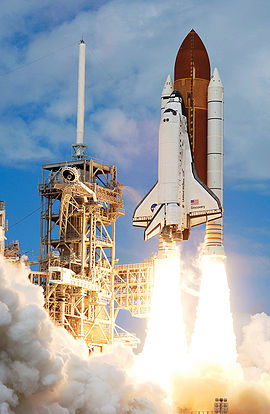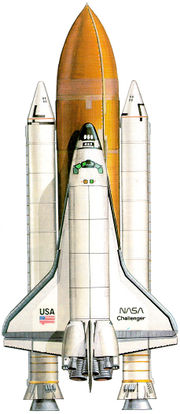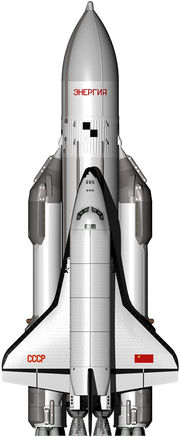Space Shuttle Enterprise
| Enterprise OV-101 |
|
|---|---|
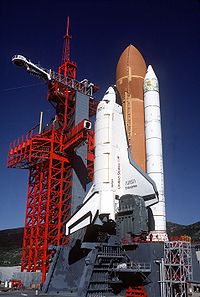 Enterprise at SLC-6 at Vandenberg AFB |
|
| OV designation | OV-101 |
| Country | United States |
| Contract award | July 26, 1972 |
| Named after | USS Enterprise (NCC-1701) |
| Status | Retired, on display at Smithsonian Institution, Steven F. Udvar-Hazy Center[1] |
| First flight | Taxi test February 15, 1977 |
| Last flight | Free flight October 26, 1977 |
| Time spent in space | Never flew in space |
The Space Shuttle Enterprise (NASA Orbiter Vehicle Designation: OV-101) was the first Space Shuttle orbiter. It was built for NASA as part of the Space Shuttle program to perform test flights in the atmosphere.[2] It was constructed without engines or a functional heat shield, and was therefore not capable of spaceflight.
Originally, Enterprise had been intended to be refitted for orbital flight, which would have made it the second space shuttle to fly after Columbia.[2] However, during the construction of Columbia, details of the final design changed, particularly with regard to the weight of the fuselage and wings. Refitting Enterprise for spaceflight would have involved dismantling the orbiter and returning the sections to subcontractors across the country. As this was an expensive proposition, it was determined to be less costly to build Challenger around a body frame (STA-099) that had been created as a test article.[2] Similarly, Enterprise was considered for refit to replace Challenger after the latter was destroyed, but Endeavour was built from structural spares instead.[2][3]
Contents |
Service
Construction began on the first orbiter on June 4, 1974.[2] Designated OV-101, it was originally planned to be named Constitution. However, a write-in campaign caused it to be renamed after the Starship Enterprise, featured on the television show Star Trek.[3]
The design of OV-101 was not the same as that planned for OV-102, the first flight model; the tail was constructed differently, and it did not have the interfaces to mount OMS pods. A large number of subsystems - ranging from main engines to radar equipment - were not installed on this vehicle, but the capacity to add them in the future was retained. Instead of a Thermal Protection System, its surface was primarily fiberglass.
In mid-1976, the orbiter was used for ground vibration tests, allowing engineers to compare data from an actual flight vehicle with theoretical models.[2]
On September 17, 1976, Enterprise was rolled out of Rockwell's plant at Palmdale, California. In recognition of its fictional namesake, Star Trek creator Gene Roddenberry and most of the principal cast of the original series of Star Trek were on hand at the dedication ceremony.[4]
Approach and landing tests (ALT)

On January 31, 1977, it was taken by road to Dryden Flight Research Center at Edwards Air Force Base, to begin operational testing.[2][5]
While at NASA Dryden, Enterprise was used by NASA for a variety of ground and flight tests intended to validate aspects of the shuttle program.[6] The initial nine-month testing period was referred to by the acronym ALT, for "Approach and Landing Test".[2][7] These tests included a maiden "flight" on February 18, 1977 atop a Boeing 747 Shuttle Carrier Aircraft (SCA) to measure structural loads and ground handling and braking characteristics of the mated system. Ground tests of all orbiter subsystems were carried out to verify functionality prior to atmospheric flight.
The mated Enterprise/SCA combination was then subjected to five test flights with Enterprise unmanned and unactivated. The purpose of these test flights was to measure the flight characteristics of the mated combination. These tests were followed with three test flights with Enterprise manned to test the shuttle flight control systems.[2]
Finally, Enterprise underwent five free flights where the craft separated from the SCA and was landed under astronaut control. These tests verified the flight characteristics of the orbiter design and were carried out under several aerodynamic and weight configurations.[7]
On August 12, 1977, the space shuttle Enterprise flew on its own for the first time.[8]
Preparation for STS-1
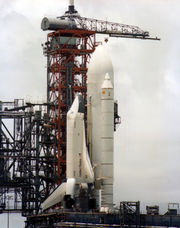
Following the ALT program, Enterprise was ferried among several NASA facilities to configure the craft for vibration testing. In June 1979, it was mated with an external tank and solid rocket boosters (known as a boilerplate configuration) and tested in a launch configuration at Kennedy Space Center Launch Pad 39A.[3]
Retirement
With the completion of critical testing, Enterprise was partially disassembled to allow certain components to be reused in other shuttles, then underwent an international tour visiting France, Germany, Italy, the United Kingdom, Canada, and the U.S. states of California, Alabama, and Louisiana (during the 1984 Louisiana World Exposition). It was also used to fit-check the never-used shuttle launch pad at Vandenberg AFB, California. Finally, on November 18, 1985, Enterprise was ferried to Washington, D.C., where it became property of the Smithsonian Institution.[3]
Post-Challenger
After the Challenger disaster, NASA had a choice of which shuttle to use as a replacement. Refitting Enterprise with all of the necessary equipment needed for it to be used in space was considered, but instead it was decided to use spares constructed at the same time as Discovery and Atlantis to build Endeavour.[3]
Post-Columbia
In 2003, after the breakup of Columbia during re-entry, the Columbia Accident Investigation Board conducted tests at Southwest Research Institute, which used an air gun to shoot foam blocks of similar size, mass and speed to that which struck Columbia at a test structure which mechanically replicated the orbiter wing leading edge. They removed a fiberglass panel from Enterprise's wing to perform analysis of the material and attached it to the test structure, then shot a foam block at it.[10] While the panel was not broken as a result of the test, the impact was enough to permanently deform a seal. As the Reinforced Carbon-Carbon (RCC) panel on Columbia was 2.5 times weaker, this suggested that the RCC leading edge would have been shattered. Additional tests on the fiberglass were canceled in order not to risk damaging the test apparatus, and a panel from Discovery was tested to determine the effects of the foam on a similarly-aged RCC leading edge. On July 7, 2003 a foam impact test created a hole 41 cm by 42.5 cm (16.1 inches by 16.7 inches) in the protective RCC panel. The tests clearly demonstrated that a foam impact of the type Columbia sustained could seriously breach the protective RCC panels on the wing leading edge.

The board determined that the probable cause of the accident was that the foam impact caused a breach of a Reinforced Carbon-Carbon panel along the leading edge of Columbia's left wing, allowing hot gases generated during re-entry to enter the wing and cause structural collapse. This caused Columbia to spin out of control, breaking up with the loss of the entire crew.
Museum exhibit
Enterprise was stored at the Smithsonian's hangar at Washington Dulles International Airport before it was restored and moved to the newly built Smithsonian's National Air and Space Museum's Steven F. Udvar-Hazy Center at Dulles International Airport, where it is the centerpiece of the space collection.[1] Space Shuttle Discovery is expected to be added to the collection once the Shuttle fleet is retired. When that happens, Enterprise will likely be loaned out to other institutions.[11] Engineers evaluated the vehicle in early 2010 and determined that it was safe to fly on the Shuttle Carrier Aircraft again.[12]
Gallery
 Enterprise ALT Program Logo. |
 Enterprise rolls out of the Palmdale manufacturing facilities with Star Trek television cast members. |
See also
- List of human spaceflights
- List of Space Shuttle crews
- List of space shuttle missions
- Timeline of Space Shuttle missions
References
- ↑ 1.0 1.1 NASA (2000). "Shuttle Enterprise at Center of Museum's Space Hangar". NASA. http://www.nasa.gov/vision/earth/everydaylife/nasm_enterprise.html. Retrieved November 28, 2007.
- ↑ 2.0 2.1 2.2 2.3 2.4 2.5 2.6 2.7 2.8 Jenkins, Dennis R. (2007). Space Shuttle: The History of the National Space Transportation System. Voyageur Press. pp. 524 pages. ISBN 0963397451.
- ↑ 3.0 3.1 3.2 3.3 3.4 NASA (2000). "Enterprise (OV-101)". National Aeronautics and Space Administration. http://www-pao.ksc.nasa.gov/kscpao/shuttle/resources/orbiters/enterprise.html. Retrieved November 28, 2007.
- ↑ Terry Lee Rioux (2005). From Sawdust to Stardust: The Biography of DeForest Kelley, Star Trek's Dr. McCoy. Simon and Schuster. p. 221.
- ↑ NASA (2005). "Space Shuttle Basics". NASA. http://spaceflight.nasa.gov/shuttle/reference/basics/. Retrieved November 28, 2007.
- ↑ NASA (2002). "Space Shuttle Approach and Landing Tests (ALT)". NASA. http://www.dfrc.nasa.gov/Gallery/Photo/ALT/HTML/. Retrieved November 28, 2007.
- ↑ 7.0 7.1 NASA - Dryden Flight Research Center (1977). "Shuttle Enterprise Free Flight". NASA. http://grin.hq.nasa.gov/ABSTRACTS/GPN-2000-000218.html. Retrieved November 28, 2007.
- ↑ 1977 Year in Review: Space Shuttle Enterprise-http://www.upi.com/Audio/Year_in_Review/Events-of-1977/Space-Shuttle-Enterprise/12361881614363-5/
- ↑ NASA (1979). "Shuttle Orbiter Enterprise on Launch Complex 39". NASA. http://images.ksc.nasa.gov/photos/1979/captions/KSC-79PC-0274.html. Retrieved January 21, 2008.
- ↑ Harwood, William (June 4, 2003). "Critical foam impact test planned for Thursday". Spaceflight Now. http://spaceflightnow.com/shuttle/sts107/030604foamtest/. Retrieved 2007-07-12.
- ↑ Berger, Eric (December 7, 2009). "Counting down to who will land a retired shuttle". Houston Chronicle. http://www.chron.com/disp/story.mpl/nation/6756689.html. Retrieved March 16, 2010.
- ↑ Bergin, Chris (March 14, 2010). "Enterprise in good condition for potential SCA ferry from Smithsonian NASM". NASAspaceflight.com. http://www.nasaspaceflight.com/2010/03/enterprise-good-condition-potential-sca-ferry-smithsonian/. Retrieved March 16, 2010.
External links
- Enterprise (OV-101) at NASA.gov
- Aerial view of Enterprise in 1978, as it is hoisted into Marshall's Dynamic Test Stand for the Mated Vertical Ground Vibration test
- Enterprise being worked on in the weight & balance hangar at Dryden Flight Research Center
- Enterprise (OV-101) at Memory Alpha (a Star Trek wiki)
- Mission Summary Archive
- NASA Ground Vibration Testing
| Spacecraft named Enterprise |
|---|
| NASA Space Shuttle (1976–1985) • Virgin Space Ship (2009—) • Star Trek starships (Fictional) |
|
||||||||||||||||||||||||||||||||||||||||||||
|
||||||||||||
